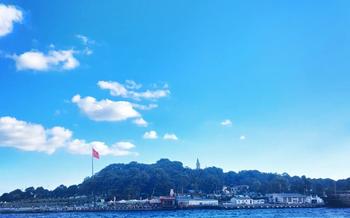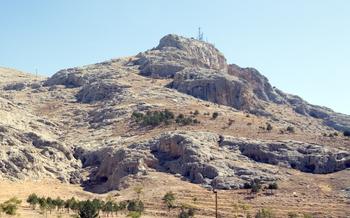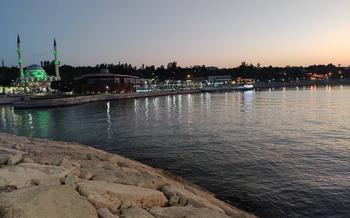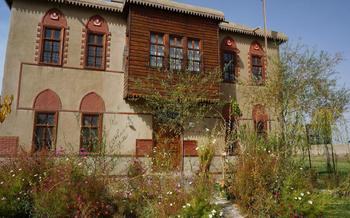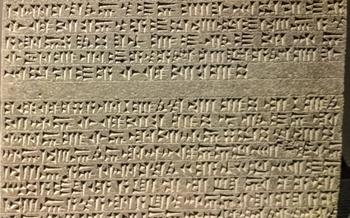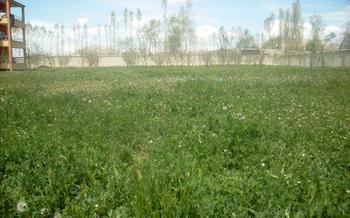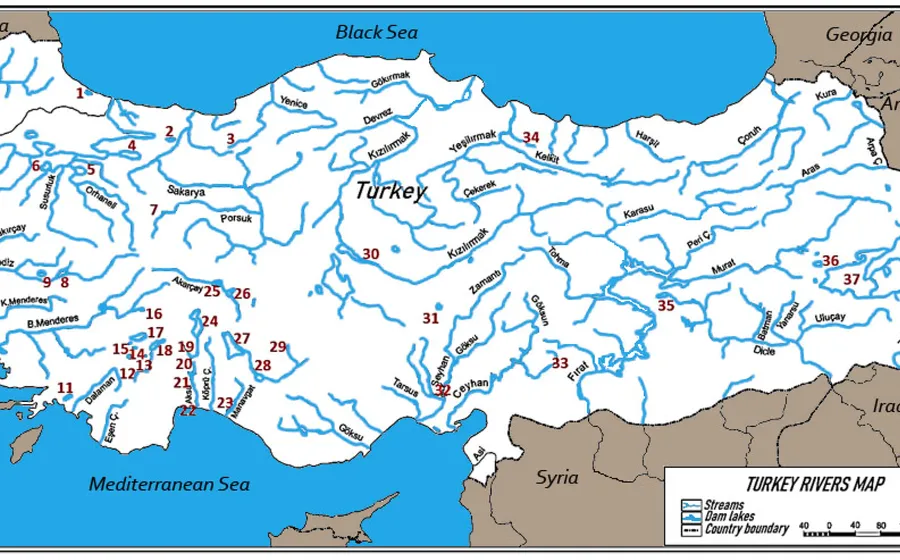
Meher Kapı Inscription
- Historical Significance
- Location:
- Physical Description
- Preservation Efforts:
- Historical Context
- Language and Script
- Translation and Interpretation:
- Cultural Significance
- Tourism and Accessibility
- Nearby Attractions:
- Local Cuisine
- Photography Tips:
- Dress Code and Etiquette
- Accommodation
- Insider Tip:
Historical Significance
The Meher Kapı Inscription stands as a testament to the rich and storied past of Van. Carved into the rocky face of a mountain overlooking the city, the inscription dates back to the 9th century BC, making it one of the oldest surviving records in the region. It is believed to have been commissioned by Sarduri II, a powerful king of the ancient kingdom of Urartu, who ruled over a vast territory stretching from the Caucasus Mountains to the shores of Lake Van.
The inscription serves as a valuable historical document, providing insights into the political and cultural landscape of Urartu during Sarduri II's reign. It chronicles the king's military campaigns, his construction projects, and his religious beliefs. The text is written in cuneiform, a complex system of writing that was widely used in ancient Mesopotamia and Anatolia. The presence of the inscription at the entrance to the city of Van suggests that it was intended to convey a message of power and authority to those who entered the city.
Location:
The Meher Kapı Inscription is strategically nestled in the ancient heart of Van, proudly adorning the entrance to the historic Van Castle. This awe-inspiring fortress, a symbol of Van's rich past, stands as a testament to the city's enduring legacy. To reach this remarkable site, embark on a journey through the vibrant streets of Van, following the signs that lead you to the castle's imposing gates. As you approach the Meher Kapı, the inscription's captivating presence will beckon you to step closer and unravel its ancient secrets.
The surrounding area is a treasure trove of historical wonders, inviting you to delve deeper into Van's captivating past. Explore the castle's majestic ramparts, each stone whispering tales of battles fought and glories won. Wander through the Armenian quarter, where centuries-old churches and monasteries stand as silent witnesses to a vibrant heritage. Immerse yourself in the bustling energy of the local markets, where the air is alive with the sounds of haggling merchants and the tantalizing aromas of traditional Turkish cuisine.
Your journey to the Meher Kapı Inscription is not merely a visit to a historical site; it is an immersive experience that will transport you back in time, allowing you to witness the grandeur of ancient Van and feel the pulse of its vibrant culture.
Physical Description
The Meher Kapı Inscription is a remarkable work of art that stands as a testament to the skill and artistry of its creators. Carved into a massive stone block, the inscription features intricate and detailed designs that have withstood the test of time. The stone itself is a deep gray in color, providing a striking contrast to the lighter-colored inscriptions that adorn its surface.
The inscription is divided into several distinct panels, each containing a variety of symbols and motifs. These include representations of animals, plants, and human figures, as well as geometric patterns and abstract designs. The figures are depicted with great precision and attention to detail, capturing the essence of movement and emotion. The overall effect is one of harmony and balance, creating a visually appealing and captivating work of art.
One of the most striking features of the inscription is its use of calligraphy. The letters are skillfully carved into the stone, forming elegant and graceful lines that flow seamlessly across the surface. The script is a combination of Armenian and Persian characters, reflecting the diverse cultural influences that shaped the region during the time of its creation. The intricate and ornate calligraphy adds to the beauty and complexity of the inscription, making it a true masterpiece of Islamic art.
Preservation Efforts:
For many years, the Meher Kapı Inscription has faced significant threats due to natural wear and tear, environmental factors, and human activity. Recognizing the importance of preserving this priceless artifact, concerted efforts have been undertaken to ensure its longevity.
To safeguard the inscription from the elements, protective measures have been implemented. Regular cleaning and maintenance are carried out to remove dirt, dust, and other harmful substances that could damage the stone's surface. Furthermore, a protective coating has been applied to the inscription to shield it from weathering and erosion.
To address the issue of human activity, restricted access to the site has been imposed. This measure aims to minimize the impact of foot traffic and prevent vandalism or accidental damage to the inscription. Designated pathways and viewing platforms have been constructed to allow visitors to admire the inscription from a safe distance without compromising its integrity.
Raising awareness about the historical significance and fragility of the inscription has been an integral part of the preservation efforts. Educational programs and signage have been implemented to inform visitors about the importance of respecting and preserving this ancient artifact. By fostering a sense of appreciation and responsibility, the local community has become actively involved in protecting the Meher Kapı Inscription for future generations.
Historical Context
The Meher Kapı Inscription stands as a testament to the rich and tumultuous history of Van. It was erected during a time of significant political and cultural change in the region. The builders of the inscription, the Urartians, were an ancient civilization that ruled over much of eastern Anatolia from the 9th to the 6th century BC. They were a powerful and influential kingdom, known for their military prowess and their advanced system of government.
The inscription itself was created during the reign of King Sarduri II, one of the most powerful and successful Urartian rulers. Sarduri II was a great conqueror, who expanded the Urartian kingdom to its greatest extent. He was also a prolific builder, and the Meher Kapı Inscription is just one of many monuments that he left behind.
The inscription records the military victories of Sarduri II and his conquests of various cities and regions. It also provides valuable insights into the religious beliefs and practices of the Urartians. The inscription is written in Urartian cuneiform, a complex writing system that was used by the Urartians to record their history and their laws.
Language and Script
The Meher Kapı Inscription is written in Old Armenian, a language that was spoken in the Armenian Highlands from the 5th to the 12th century. The script used is the Armenian alphabet, which was developed in the early 5th century by Mesrop Mashtots, a prominent Armenian linguist and theologian. The Armenian alphabet consists of 39 letters, each representing a specific sound. It is one of the few alphabets in the world that has remained largely unchanged since its creation.
The use of Old Armenian and the Armenian alphabet in the Meher Kapı Inscription is significant for several reasons. First, it demonstrates the widespread use of the Armenian language and script in the region during the medieval period. Second, it provides valuable insights into the development of the Armenian alphabet and its role in preserving Armenian culture and identity.
Translation and Interpretation:
The Meher Kapı Inscription has been translated and interpreted by scholars and historians over the years. The text is written in a combination of Armenian and Persian languages, using a unique script that blends elements of both cultures. The inscription provides valuable insights into the political and cultural landscape of the region during the medieval period.
Interpretations of the text vary, with some scholars focusing on its historical significance, while others explore its religious and cultural implications. The inscription mentions several historical figures and events, shedding light on the political alliances and conflicts of the time. It also contains references to religious beliefs and practices, offering glimpses into the diverse spiritual traditions of the region.
However, the interpretation of the inscription is not without its challenges. The unique script and the fragmentary nature of the text have led to different readings and interpretations among scholars. Despite these challenges, the Meher Kapı Inscription remains an invaluable source of information, providing a window into the complex and fascinating history of Van.
Cultural Significance
The Meher Kapı Inscription holds immense cultural significance for the people of Van and beyond. It serves as a tangible link to the region's rich and diverse past, offering insights into the beliefs, traditions, and practices of ancient civilizations. The inscription has become an integral part of the local identity, a symbol of pride and heritage.
Throughout history, the Meher Kapı Inscription has been a source of inspiration and intrigue for scholars, researchers, and the general public alike. Its captivating script and enigmatic symbols have sparked countless debates and discussions, contributing to the intellectual and cultural discourse of the region.
Moreover, the inscription has played a crucial role in shaping the cultural identity of Van. It has fostered a sense of belonging and unity among the local communities, who view it as a symbol of their shared history and heritage. The preservation and celebration of this ancient artifact have helped to strengthen the cultural fabric of the region and promote a sense of cultural continuity.
Tourism and Accessibility
The Meher Kapı Inscription is a popular tourist destination in Van, attracting visitors from all over the world. The site is easily accessible, located in the heart of the city, just a short walk from the city center. Visitors can reach the inscription by foot, by car, or by public transportation. Once there, they will find a well-maintained park with walkways and benches, providing a peaceful and pleasant environment to explore the inscription. Guided tours are available for those who want to learn more about the history and significance of the inscription. These tours are conducted by knowledgeable guides who can provide insights into the ancient world of Van and the fascinating story behind the Meher Kapı Inscription.
Nearby Attractions:
For an enriched cultural experience, combine your visit to the Meher Kapı Inscription with explorations of other nearby attractions in Van. Just a short distance away, discover the Van Museum, a treasure trove of archaeological wonders and artifacts that narrate the captivating history of the region. Immerse yourself in the stories of ancient civilizations and marvel at the exquisite craftsmanship of artifacts that have stood the test of time.
Venture further to explore the scenic shores of Lake Van, the largest soda lake in the world. Take a leisurely stroll along the picturesque promenade, bask in the tranquility of the shimmering waters, and admire the stunning panoramic views of the surrounding mountains. Indulge in a boat tour to witness the lake's unique ecosystem, home to diverse bird species and natural wonders like the Akdamar Island, a historic Armenian monastery that stands as a testament to the region's rich cultural heritage.
For those seeking spiritual enlightenment, embark on a pilgrimage to the Holy Cross Cathedral, an ancient Armenian church that exudes an aura of reverence and architectural splendor. Its intricate carvings and serene atmosphere invite contemplation and reflection, offering a glimpse into the region's deep-rooted religious traditions.
Plan your itinerary strategically to make the most of your time in Van. Consider dedicating a full day to exploring the Meher Kapı Inscription, the Van Museum, and the Holy Cross Cathedral, immersing yourself in the region's rich history and cultural tapestry. Allocate another day to experience the natural wonders of Lake Van, taking a boat tour and exploring the scenic surroundings. This comprehensive itinerary will ensure a well-rounded and unforgettable visit to this captivating city.
Local Cuisine
The city of Van boasts a rich and diverse culinary tradition that reflects its unique geographical location and cultural influences. While visiting the Meher Kapı Inscription, be sure to savor the local delicacies that the city has to offer.
One of the must-try dishes in Van is kavurma, a slow-cooked lamb stew flavored with local herbs and spices. Served with a side of fluffy rice or crusty bread, this hearty dish is a feast for the senses.
For a taste of authentic Van street food, try murtuğa, a savory pastry filled with spiced potatoes and herbs. These crispy treats are perfect for a quick snack or as a side dish to a larger meal.
Don't miss the opportunity to indulge in Van kahvaltısı, a traditional Turkish breakfast spread featuring a variety of local cheeses, honey, jams, and freshly baked bread. This hearty breakfast is a great way to start your day of exploration in Van.
To satisfy your sweet cravings, try Van dondurması, a unique ice cream made with sahlep, a type of orchid root powder, that gives it a stretchy texture and a nutty flavor. This frozen treat is a beloved local specialty and a must-try for visitors to Van.
When dining in Van, take the opportunity to explore the local restaurants and cafes. Many establishments offer stunning views of the city and the surrounding mountains, making your dining experience even more memorable.
Photography Tips:
For capturing stunning photographs of the Meher Kapı Inscription, consider the following tips:
-
Best Angles: Position yourself slightly below the inscription to capture its full grandeur against the backdrop of the surrounding landscape.
-
Lighting Conditions: Aim for early morning or late afternoon light to minimize harsh shadows and create a warm, golden glow on the inscription's surface.
-
Camera Settings: Use a wide-angle lens to encompass the entire inscription in your frame. Adjust your aperture to achieve a sharp focus on the text while blurring the background.
-
Personal Experience: During my visit, I found that using a tripod allowed me to stabilize my camera for crisp, blur-free shots. Experimenting with different shutter speeds also helped me convey the dynamic energy of the surrounding environment.
Dress Code and Etiquette
When visiting the Meher Kapı Inscription, it is essential to be respectful of local customs and traditions. While there is no strict dress code, it is advisable to dress modestly and avoid wearing revealing or overly casual clothing. This shows respect for the historical and cultural significance of the site. Additionally, visitors should be mindful of their behavior and maintain a respectful demeanor. Loud talking, boisterous behavior, and littering are discouraged. By following these guidelines, visitors can contribute to preserving the sanctity of this ancient artifact and ensure a pleasant experience for everyone.
Accommodation
When exploring the captivating city of Van and its historical treasures, finding suitable accommodation is essential for a comfortable and memorable stay. Fortunately, visitors to the Meher Kapı Inscription are spoiled for choice with a range of lodging options to suit various preferences and budgets.
In the immediate vicinity of the site, numerous hotels and guesthouses offer convenient access to this ancient artifact. These accommodations range from cozy family-run establishments to modern hotels with contemporary amenities. Whether you seek a budget-friendly option or a luxurious retreat, you're sure to find something that meets your needs.
For those seeking a truly immersive experience, consider staying in one of the traditional guesthouses that dot the city. These charming establishments often provide a glimpse into the local culture and lifestyle, allowing you to connect with the warmth and hospitality of the Van people.
No matter your choice of accommodation, ensure it is within easy reach of the Meher Kapı Inscription to make the most of your visit. Stroll through the city's vibrant streets, savor the delectable local cuisine, and immerse yourself in the rich history and culture that Van has to offer.
Insider Tip:
For an unforgettable experience, visit the Meher Kapı Inscription during the annual Van Festival. Held in July, this vibrant celebration showcases the rich cultural heritage of the region. Immerse yourself in traditional music, dance, and local delicacies as the city comes alive with festivities. Take advantage of this opportunity to engage with the friendly locals and learn about their unique customs and traditions. Discover the hidden gems of Van and create memories that will last a lifetime.


